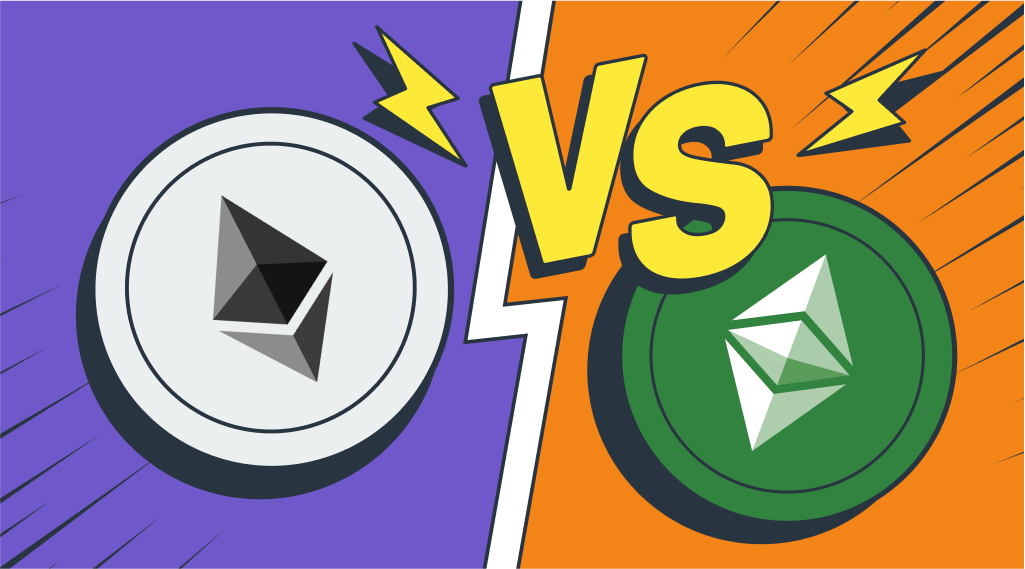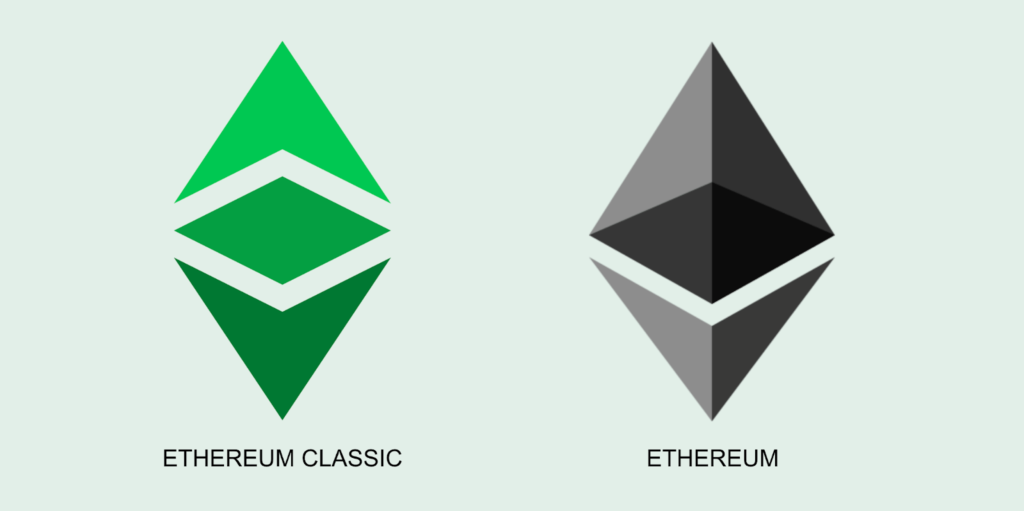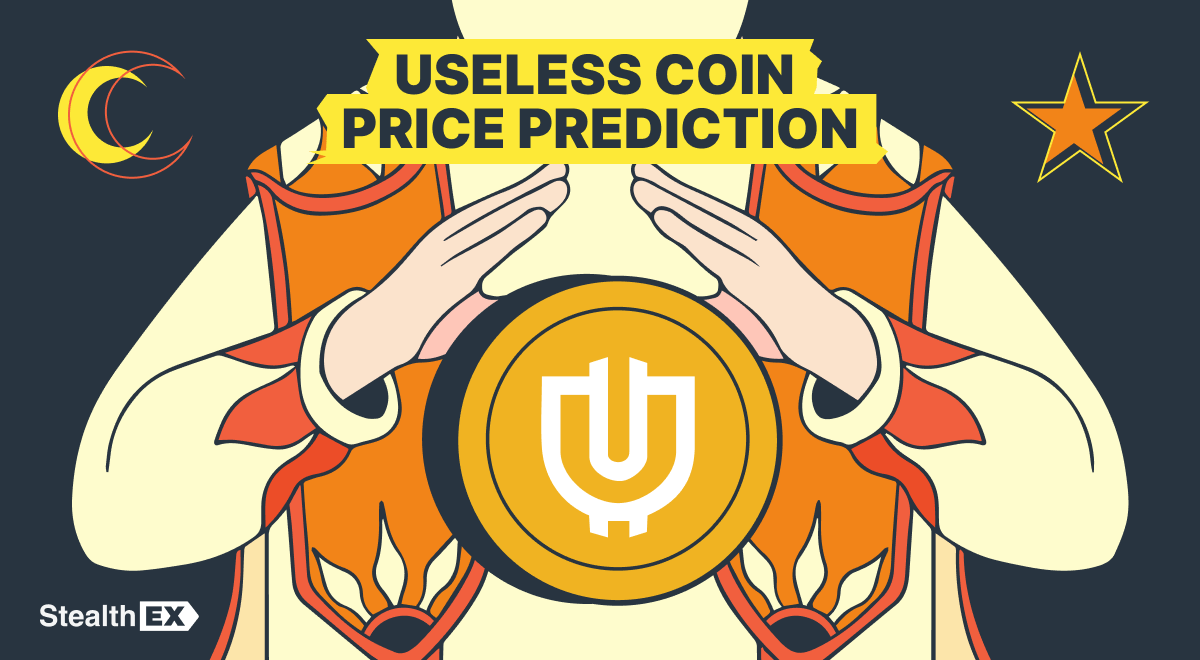Ethereum Classic vs Ethereum – What Is the Difference? Compare ETC and ETH

Ethereum Classic vs Ethereum: ETC and ETH, two prominent names in the blockchain world, often create confusion among enthusiasts and newcomers alike. While they share a common origin, their paths diverged after a significant event in 2016. This article delves into the key differences between these two platforms, shedding light on their distinct features and development philosophies. Join us as we unravel the intricacies of Ethereum and Ethereum Classic and explore the factors that set them apart.

Article contents [hide]
- 1 What Is Ethereum (ETH)?
- 2 What Is Ethereum Classic (ETC)?
- 3 Ethereum Classic vs Ethereum – Key Differences Between ETH and ETC
- 4 Ethereum Classic vs Ethereum – Similarities
- 5 ETH vs ETC – Comparison Table
- 6 Ethereum Classic vs Ethereum – Highest Price Ever – ATH
- 7 Summary
- 8 FAQ About Ethereum Classic vs Ethereum
- 8.1 What Caused the Split Between Ethereum and Ethereum Classic?
- 8.2 Are Ethereum (ETH) and Ethereum Classic (ETC) the Same?
- 8.3 Can I Use Ethereum Smart Contracts on Ethereum Classic and Vice Versa?
- 8.4 Which Has a Higher Market Capitalization, ETH or ETC?
- 8.5 Are Both Ethereum and Ethereum Classic Transited to Proof of Stake (PoS)?
- 8.6 Which Platform Has More Decentralized Applications (DApps)?
- 8.7 Why Is the Principle of “Code Is Law” Significant for Ethereum Classic?
What Is Ethereum (ETH)?
Ethereum (ETH) is a decentralized, open-source blockchain platform that enables the creation and execution of smart contracts. These smart contracts are self-executing contracts with the terms of the agreement directly written into code.
Ethereum’s native cryptocurrency is Ether (ETH), compensating participants who perform computations and validate transactions. Unlike Bitcoin, which is primarily a digital currency, Ethereum focuses on running the programming code of decentralized applications (DApps). Users send ETH to these smart contracts, triggering their execution.
The Ethereum network is maintained by a decentralized group of PoS validators (after Merge) who validate and record transactions on the blockchain. For their efforts in securing blockchain, they are rewarded with ETH. Ethereum also introduced the concept of “gas,” which is a unit that measures the amount of computational effort required to execute operations.
The Ethereum platform has spurred the development of thousands of DApps and has paved the way for Initial Coin Offerings (ICOs) and NFTs. In essence, Ethereum offers a decentralized platform for developers to build and deploy their applications without intermediaries.
What Is Ethereum Classic (ETC)?
Ethereum Classic (ETC) is a decentralized blockchain platform that emerged from a split in the original Ethereum network in 2016. The split, or “fork”, occurred due to disagreements in the Ethereum community after a major hack in the DAO (Decentralized Autonomous Organization) project.
While most of the community decided to reverse the hack and restore the stolen funds by creating a new version of Ethereum, a subset believed in the principle of “code is law” and chose to continue on the original chain, naming it Ethereum Classic.
Like Ethereum, ETC also supports smart contracts. Ethereum Classic’s native cryptocurrency is also called Ether, but it’s denoted as ETC to distinguish it from Ethereum’s ETH.
Miners validate and record transactions on the ETC blockchain, and they’re compensated with ETC for their efforts. The platform uses the same “gas” system as Ethereum to measure computational efforts for operations.
Ethereum Classic has evolved independently despite its origins, with its own updates and development roadmap. ETC upholds the principle of immutability, emphasizing that transactions and smart contracts, once executed, should remain irreversible. This philosophy differentiates it from Ethereum and guides its community and development decisions.
Ethereum Classic vs Ethereum – Key Differences Between ETH and ETC
Certainly! Here are the key differences between Ethereum (ETH) and Ethereum Classic (ETC):
- Origin: Both Ethereum and Ethereum Classic originated from the same blockchain. However, they split in 2016 due to disagreements in the community after the DAO hack. Ethereum (ETH) is the new chain, while Ethereum Classic (ETC) continued on the original chain.
- Philosophy: Ethereum decided to reverse the DAO hack and restore the stolen funds. Ethereum Classic upheld the principle of “code is law,” emphasizing that transactions, once executed, should remain irreversible.
- Community and Development: Post-fork, most developers and the original Ethereum community shifted to the Ethereum (ETH) chain. Ethereum Classic (ETC) has a smaller but dedicated community.
- Security: Ethereum has moved towards a Proof of Stake (PoS) consensus mechanism with its Ethereum 2.0 upgrade, aiming for scalability and energy efficiency. Ethereum Classic, similar to Bitcoin, remains with the Proof of Work (PoW) mechanism.
- Supply: Ethereum (ETH) does not have a fixed supply cap, while Ethereum Classic (ETC) has a fixed supply cap of 210 million ETC.
- Development Roadmap: Both platforms have distinct development roadmaps. Ethereum focuses on scalability and other upgrades like sharding with Ethereum 2.0. Ethereum Classic focuses on maintaining its original vision and improving its existing system.
- Adoption: Ethereum (ETH) has seen wider adoption, with a larger ecosystem of decentralized applications (DApps) and Decentralized Finance (DeFi) projects. Ethereum Classic (ETC) has fewer DApps in comparison.
- Price and Market Capitalization: Ethereum (ETH) has historically maintained a higher market capitalization and price than Ethereum Classic (ETC).
- Interoperability: Ethereum has been working on solutions for interoperability with other blockchains. Ethereum Classic, while open to collaborations, has a more focused approach to its own chain’s development.
- Institutional Interest: Ethereum (ETH) has garnered significant institutional interest, with many viewing it as a major player in the blockchain space. Ethereum Classic (ETC) has seen some interest as well, but not as much as ETH.
Choose StealthEX for Exchange and Buy Crypto
- User-Friendly — Simple and minimalistic interface for everyone.
- Fast and Private — Instant non-custodial cryptocurrency exchanges.
- Buy crypto with Credit Card.
- 1300+ coins and tokens are available for limitless, quick and easy exchanges.
- NO-KYC crypto exchanges — Buy cryptocurrency up to €700 without KYC!
- StealthEX crypto exchange app — Process crypto swaps at the best rates wherever you are.
- 24/7 Customer Support.
Earn from Each Exchange by Joining StealthEX Affiliate Program.
Become a partner right now and use affiliate tools:
- Public API — Earn from your wallet, aggregator, or exchange terminal.
- Referral Links — Recommend StealthEX to your audience.
- Exchange Widget — Built crypto exchange widget on any page of your website.
- Button — A perfect choice for traffic monetization.
- Banner — Track conversion and stats right in the personal cabinet.
Ethereum Classic vs Ethereum – Similarities
Despite their differences, Ethereum (ETH) and Ethereum Classic (ETC) share several similarities due to their common origin:
- Blockchain Technology: Ethereum and Ethereum Classic are decentralized platforms based on blockchain technology.
- Smart Contracts: Both platforms support the creation and execution of smart contracts.
- Ether Cryptocurrency: Both have a native cryptocurrency called Ether. However, Ethereum is denoted as ETH and Ethereum Classic as ETC to distinguish between the two.
- Gas System: Ethereum and Ethereum Classic use “gas” to measure the computational effort required to execute operations, ensuring that users pay for the computational power they consume.
- Proof of Work: Both Ethereum and Ethereum Classic initially operated using the Proof of Work (PoW) consensus mechanism. However, it’s worth noting that Ethereum transitioned to Proof of Stake (PoS) with its Ethereum 2.0 upgrade.
- EVM: Both platforms utilize the Ethereum Virtual Machine (EVM) to process smart contracts and ensure application interoperability.
- Decentralization: ETH and ETC prioritize a decentralized approach, ensuring that no single entity controls the entire network.
- Open-Source: Ethereum and Ethereum Classic are open-source platforms, meaning their code is publicly available, and anyone can contribute to their development.
- Community-Driven: Both platforms are driven by their respective communities, which propose and implement changes, updates, and improvements to the systems.
While Ethereum and Ethereum Classic have taken different paths since the 2016 fork, they still share foundational principles and functionalities rooted in their shared history.
ETH vs ETC – Comparison Table
Here’s a comparison table highlighting the differences between Ethereum (ETH) and Ethereum Classic (ETC):
| Feature | Ethereum (ETH) | Ethereum Classic (ETC) |
| Origin | Resulted from a fork in 2016 after the DAO hack. | Original chain continued after the DAO hack. |
| Philosophy | Reversed the DAO hack to restore stolen funds. | Upholds ‘code is law’, keeping the DAO hack irreversible. |
| Community & Development | Majority of original developers and community. | Smaller, dedicated community. |
| Consensus Mechanism | Transited to Proof of Stake (PoS) with Ethereum 2.0. | Remains with Proof of Work (PoW). |
| Supply | No fixed supply cap. | Fixed supply cap of 210 million ETC. |
| Development Roadmap | Focuses on scalability with Ethereum 2.0. | Maintains original vision with improvements. |
| Adoption | Wider adoption with more DApps and DeFi projects. | Fewer DApps in comparison to ETH. |
| Price & Market Cap | Historically higher market cap and price. | Lower market cap and price compared to ETH. |
| Interoperability | Working on solutions for interoperability. | Focused on its own chain’s development. |
| Institutional Interest | Significant institutional interest. | Less institutional interest compared to ETH. |
Ethereum Classic vs Ethereum – Highest Price Ever – ATH
Ethereum (ETH) and Ethereum Classic (ETC) have experienced significant price surges. Here’s a brief overview of their all-time high (ATH) prices:
- Ethereum (ETH): Ethereum’s price skyrocketed during the crypto bull run of 2021, reaching an all-time high of $4,379.
- Ethereum Classic (ETC): Ethereum Classic saw its price surge to a peak of $42 during the 2017 bull run. However, amid the resurgence of buying momentum in 2021, ETC’s price reached an all-time high of $134.
These prices reflect the dynamic nature of the cryptocurrency market and the factors that influence the valuation of Ethereum and Ethereum Classic. It’s essential to note that cryptocurrency prices are highly volatile and can change rapidly based on market conditions, technological advancements, regulatory changes, and other factors.
Summary
Ethereum (ETH) and Ethereum Classic (ETC) are both blockchain platforms that support smart contracts, but they diverged after a contentious hard fork in 2016. The split was a result of differing views on how to handle the DAO hack. While ETH implemented changes to reverse the hack’s effects, ETC chose to uphold the principle of immutability.
Both platforms share the same foundational technology and vision, but ETH has seen more widespread adoption, innovations, and higher market capitalization. ETC, on the other hand, remains true to its original ethos. Despite their differences, both have played significant roles in the evolution of the blockchain ecosystem.

FAQ About Ethereum Classic vs Ethereum
What Caused the Split Between Ethereum and Ethereum Classic?
The split was a result of the DAO hack in 2016. While the majority of the Ethereum community decided to reverse the hack and restore the stolen funds, a subset believed in the principle of “code is law” and continued on the original chain, naming it Ethereum Classic.
Are Ethereum (ETH) and Ethereum Classic (ETC) the Same?
No. While they share a common origin, their paths diverged after the 2016 DAO hack. They now have different development roadmaps, communities, and philosophies.
Can I Use Ethereum Smart Contracts on Ethereum Classic and Vice Versa?
In principle, yes, since both platforms support the Ethereum Virtual Machine (EVM). However, due to differences in network upgrades and features, some contracts might require modifications to work on both chains.
Which Has a Higher Market Capitalization, ETH or ETC?
Historically, Ethereum (ETH) has maintained a higher market capitalization compared to Ethereum Classic (ETC).
Are Both Ethereum and Ethereum Classic Transited to Proof of Stake (PoS)?
Only Ethereum (ETH) transited to PoS with its Ethereum 2.0 upgrade. Ethereum Classic (ETC) continues to use the Proof of Work (PoW) consensus mechanism.
Which Platform Has More Decentralized Applications (DApps)?
Ethereum (ETH) has seen wider adoption and has a larger ecosystem of DApps compared to Ethereum Classic (ETC).
Why Is the Principle of “Code Is Law” Significant for Ethereum Classic?
The “code is law” principle emphasizes that transactions and smart contracts, once executed, should remain irreversible. This philosophy differentiates Ethereum Classic from Ethereum and guides its community and development decisions.
Follow us on Medium, Twitter, Telegram, YouTube, and Publish0x to stay updated about the latest news on StealthEX.io and the rest of the crypto world.
This article is not supposed to provide financial advice. Digital assets are risky. Be sure to do your own research and consult your financial advisor before investing.
ETC ETH Ethereum Ethereum 2.0 Ethereum classicRecent Articles on Cryptocurrency
 Useless Coin Price Prediction: Is USELESS Crypto a Good Investment?
Useless Coin Price Prediction: Is USELESS Crypto a Good Investment?  OFFICIAL TRUMP Coin Price Prediction: How High Will TRUMP Crypto Go?
OFFICIAL TRUMP Coin Price Prediction: How High Will TRUMP Crypto Go? 